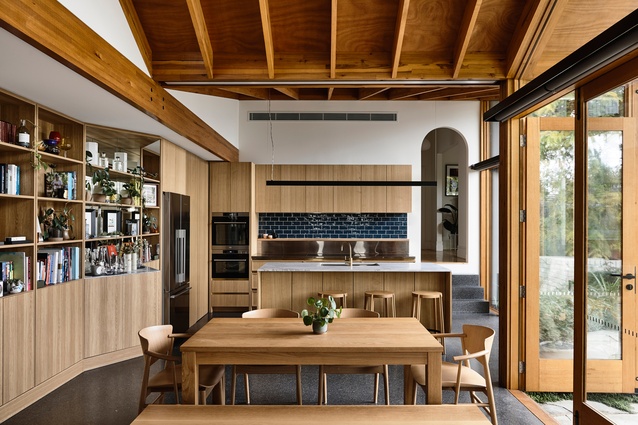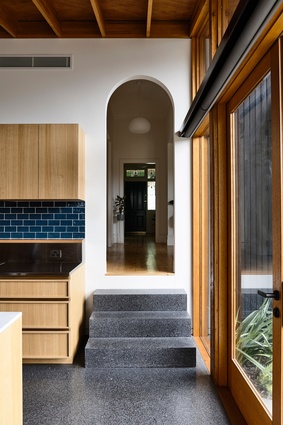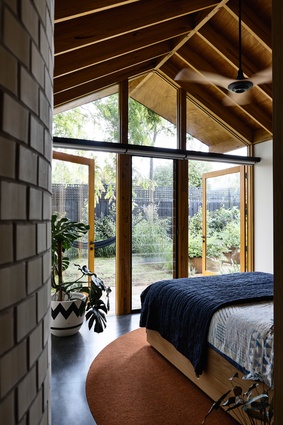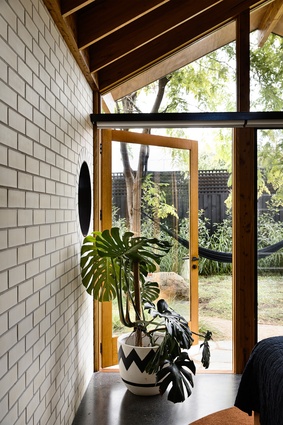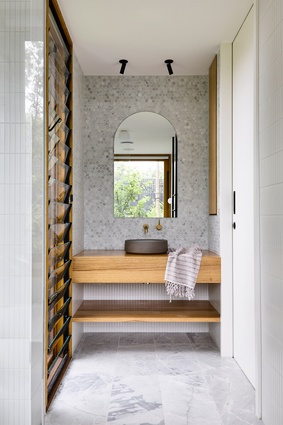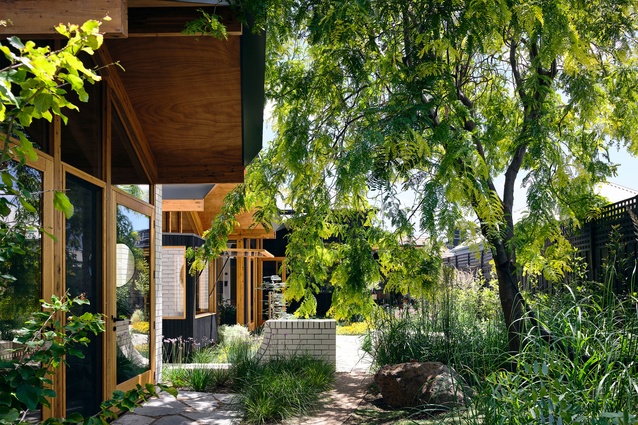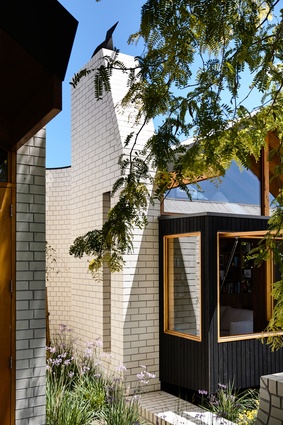‘A cascading series of salon spaces’: Garden House
Soft boundaries create multipurpose spaces that reflect a young couple’s character while generous windows connect interiors with “domesticated wilds” around this fluid, functional Melbourne home.
What is a house for? Not every house is for the same thing. Well, obviously there are some common purposes – climate control, keeping the rain out, facilitating sleeping, storing things, preparing food and drink etc. This last category is normally fulfilled by something called a “kitchen,” but there is a danger in using labels – they are ready-mades, stereotypes, clichés. Better not to name it at all – that way, it is more likely to appear to you afresh, as a unique thing, a particular instance, strange.
At this house in Fitzroy North, designed by BKK Architects, every space has multiple potential uses and each zone bleeds into the next. There is a place for storing and preparing food, hanging out with friends, washing dishes – the usual kitchen things – and also slightly less usual things, like making cocktails (the alcohol cabinet is integrated into the kitchen end of the bookshelves), and, most importantly, gazing out at the garden. This last activity pretty much applies to every space in the house. Only a cinema/computer games room and a guest bedroom don’t face the new “wilds” that replaced the old lawn (it would be wrong to label it a “backyard”).
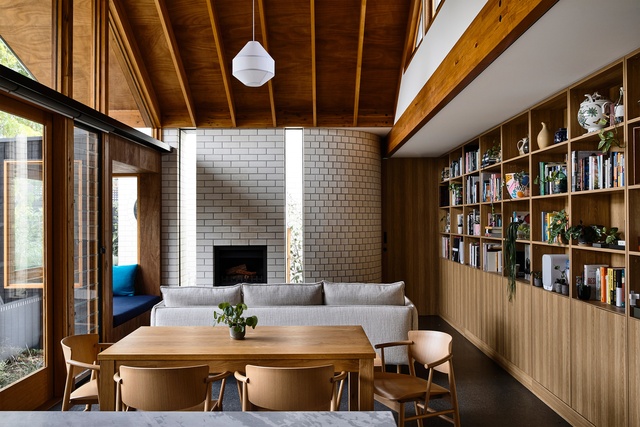
BKK has been designing houses for 20 years, and one thing that has shaped its designs over that time is the rejection of real-estate-style labelling of spaces; instead, the practice goes for looser definitions, encompassing a broader range of potential uses. This is reflected in the briefing exercise the architects employed for this house. They gave the clients a plan of the site showing roughly where the new additions were going, and asked them things like, “Where would you like to sit? To eat? To lie down?” BKK tries to create spaces that can be occupied in unexpected and unplanned ways; ways that are unique to the personality of the occupants.
The concept of personality was also part of the briefing process. The architects asked the clients, a young couple, to provide two images each that expressed something about who they are. They specifically said not to provide images of architecture. She provided a tranquil photograph of wilderness and a still-life painting of a vase of flowers, and he a sci-fi movie poster and an illustration of wolves. She grew up in the Otway Ranges and loves to garden, and he thinks of himself as a lone wolf who sometimes likes to run with the pack.
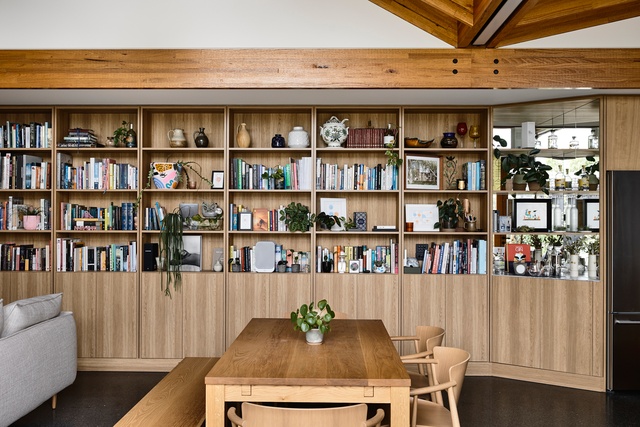
According to BKK director Simon Knott, they both identify as introverts. They intend to live in the house for a significant period of time. Providing a photo of a landscape, a painting of a bunch of flowers and some wolves, rather than, say, images of domestic interiors, opens up possibility, and increases the chance for a design to emerge outside of preconceived ideas of what a house should be.
Simon describes the house at one point as a “cascading series of salon spaces”; spaces for introverts to be alone, but with the option of mingling together, and even of hosting big parties if they open up the doors and windows to the outdoors. BKK have called it Garden House, and the name is apt, because every space is oriented outwards, facing the domesticated wilds. The facade line pops out and squeezes back in, the ceiling rises and falls, but at every opportunity, the architecture places your body near a window.
And you do turn to look – because out there lies abundance, bounty, beauty. Verdant green or autumnal orange, lit with high contrast, or the glowing, saturated colour produced by Melbourne’s overcast skies, depending on the moment in time. The client’s two cats are a litmus test of the best window seats in the house, but they don’t stay put, instead migrating nomadically with the movement of the sun. The same goes for the human occupants – depending on mood, task or situation, they can find their place here, in this variegated landscape of interior spaces.
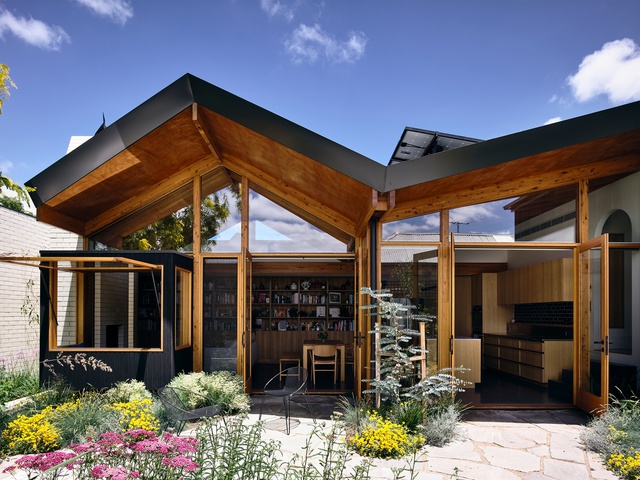
So, what is a house for? Perhaps we can infer that BKK places the highest priority on expressing the character of the occupants. Simon describes the house as a “container for living,” and he is particularly keen on the role of bookshelves. The southern spine of Garden House is entirely shelves, displaying books and a collection of ceramics. “Bookshelves are like a timeline of your life,” says Simon. “It gives the whole space a character, a personality. It’s something that architecture alone can never achieve.” He describes the bookshelves as a second facade, its quality created and curated by the clients, and accumulated over a lifetime – a true portrait of their personality.
This article first appeared on architectureau.com.

